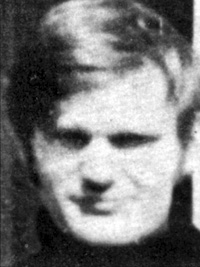17 June 2004 Edition
Paras were a 'death squad out to get some kills' - Bloody Sunday Inquiry
BY FERN LANE

Bloody Sunday victim Jim Wray
The four soldiers who opened fire on Bloody Sunday victim Jim Wray were nothing less than a "death squad" who had resolved beforehand to "get some kills". That was the damning assessment of Lord Anthony Gifford QC, lawyer for the Wray family, as he made his final submission to the Saville tribunal on Monday. The soldiers he referred to are known only be the letters F, G, H and E.
Lord Gifford also told the inquiry that Edward Heath bore a great proportion of the responsibility for the events of the day. Contrary to his subsequent claims, Heath in fact had a "close personal involvement" in the situation in the north of Ireland and, when faced with a choice between "a path of confrontation" with civilians marching against injustice and a "path of tolerance and accommodation and consultation", Heath had chosen the former.
"He made a choice in favour of strong action by the army against the marchers," said Gifford. "We say it was plainly obvious that if you authorise the Army to be resolute in confronting a march of 8,000 to 12,000 citizens, [in] confronting them with 20 companies of troops, you are risking bloodshed on a potentially large scale."
But the message that had come from the government was "stop that march because they are hooligans and IRA sympathisers", he continued; "and that was where the Government had a fatal responsibility for the events which followed".
On the matter of the killing of Jim Wray, Lord Gifford described it as an "atrocity".
"He was shot twice in the back. He was shot first as he fled across Glenfada Park North, a shot which would probably, but not inevitably, have been fatal on its own. He was shot a second time in even more appaling circumstances, as he lay on the ground trying to raise himself and crawl to safety. He was murdered by a group of soldiers who called themselves a 'brick', but which we have called a death squad.
"They all opened fire at more or less the same time, within seconds of each other," he continued. "If it had been a squad of underworld hitmen shooting members of a rival gang, there would be no hesitation in a prosecuting authority in charging every member of the squad with the murder of every victim who died."
Gifford highlighted the evidence of Soldier 027, who he said, had broken ranks and attempted to descript the "violent, prejudiced side of army life; the state of hatred for the Catholic enemy which affected the ordinary soldiers.
"This violent, prejudiced side of Army life has surfaced in history many times, from Amritsar to Mali, to Bloody Sunday, to Abu Ghraib. It happens when an occupying force becomes so affected with hatred and contempt for the people of its occupied land, that some of its members break discipline and commit atrocities."
The four soldiers, he said, had a "common purpose"; to teach the Derry youth a lesson. "The purpose was formed by F and G and, at the least, the other members of their brick, at some time before they entered the Bogside, that if the chance arose they would unleash unlawful violence upon the youths of Derry. When the chance of the operation took them... in pursuit of men who had escaped from the barricade, into the enclosed, private, secure area of Glenfada Park North, with the hated Derry youth fleeing before their eyes, they put purpose into action, all four of them.
"Is it coincidence that four soldiers, together in the same spot at the same time, all committed individual acts of murder or attempted murder?" he asked. "Of course not. The final telling indicator was given by the words of Soldier G as he came back from Abbey Park - 'I have got another one' - the triumphant report of a team member who has done what the team expected of him."
The shooting of Wray as he lay on the ground, by either soldier H or G, was, said Lord Gifford, "another act of criminal violence".
"It was not just unlawful, but merciless and inhuman in character, so much so that the soldiers' representatives have sought to argue that it did not happen; just another piece of Derry folklore, they say. That submission is an insult to those many witnesses who saw the shot and its effects... not to mention the family of Jim Wray.
"That shot was, like the shooting of Barney McGuigan, one of the defining moments of that day, a moment which confirms that these soldiers were not shooting out of some possibly excusable spur-of-the-moment sense of danger, but out of a deliberate resolve to get some kills."
